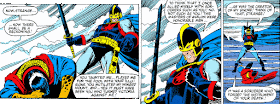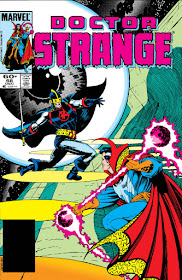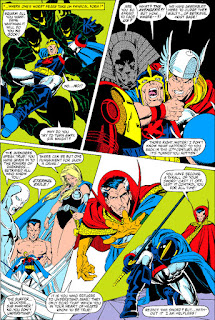Often the best Dr. Strange stories are those where Strange's confidence in his abilities works in tandem with a methodical investigation to unravel a mystery that ends with his satisfaction as well as our own. One classic example would be "The House Of Shadows!" from 1964, but there are a number of others--including "Sword & Sorcery," a 1984 tale which featured Strange's reunion with Dane Whitman, the Black Knight, following the Knight's return to the 20th century at long last (capping a series of events set in motion when he crossed paths once more with the Enchantress).
But this is a very different Black Knight--and Strange may not live long enough to solve this mystery.
Written by Roger Stern, with artwork by Paul Smith and Terry Austin, Strange at last delves into the curse of the Black Knight's ebony blade--one that began with his ancestor, Sir Percy of Scandia, and which now haunts the very disturbed Dane Whitman.
The mystery begins with Strange answering an urgent call from Victoria Bentley, a mutual friend of himself and the Knight, who has been helping Dane readjust to the present but is concerned for his state of mind.
The proof of Victoria's unease regarding Dane comes with a visit to the stables, where his veterinarian, who's treating his winged steed Valinor which returned with him from the 12th century, is receiving a tongue-lashing concerning his inability to help the animal which has fallen ill. Strange's intervention results in a touching scene that allows Stern and Smith to not only provide a nice bit of characterization for Strange, but also to use the same scene to more clearly reveal Dane's difficulties.
With Dane resting under one of Strange's spells, Strange uses the Eye of Agamotto to pierce his thoughts and provide some insight into his troubled mind. What he discovers are symptoms of PTSD, a condition first diagnosed four years before this story saw publication and which Strange believes is tied to the bloody battles Dane fought during the Crusades--but the door is also opened to troubles which may relate directly to the Knight's enchanted sword.
(At least part of Dane's problem could have been alleviated by Victoria offering him the opportunity to buy back the castle; or she simply could have paid the castle's taxes in his absence and be reimbursed upon his return. Yet they're moot points, given Stern's insistence that Victoria's decision be added to Dane's woes.)
To explore the situation further, Strange descends to the lower chambers of Garrett Castle where he finds the Brazier of Truth, which he lights to bring forth the shade of Sir Percy, just as the Knight has done on occasion. Long ago, it was Sir Percy who had suggested destroying the sword when the Knight first came to understand the effect it was having on him when dealing with London's criminal element:
From Stonehenge, the Knight was transported to the world of Arkon, where he was to hurl his sword into the mystic Well At The Center Of Time--which he accomplished after the Avengers arrived to save him from Arkon and the Enchantress. But instead of being destroyed in the explosion which followed, the sword materialized, intact, in Olympus of all places, where Ares, the God of War, discovered it and used it to launch a plan which would conquer not only Olympus but Asgard and Earth as well.
But once the Knight and Thor confront Ares in Olympus, that plan meets defeat along with Ares--and the Knight reclaims the sword, for better or worse.
Now, however, Sir Percy suggests a different approach be taken--one which not only points the way toward helping Dane but could also free himself from his current existence in spirit form.
To carry out his plan, Strange indeed hands over the sword, and then sees to Victoria's safety. From there, he invokes a challenge that he knows Dane, in his current state, won't refuse.
Unfortunately, due to an unrelated attack through the dimensions by Umar, the sister of the Dread Dormammu, Strange's illusion is shattered, forcing him to instead subject the Knight to the realm of madness in order to confront him with the roots of his own mania. The gambit succeeds--but there is still work to be done before Dane can be free from the sword's curse.
Strange's words are curious in light of the steps the Knight took on Arkon's world to do the very thing that Strange proposes, but there's an important distinction: While the Well At The Center Of Time was also of mystic origin, the sword wasn't so much "cleansed" as presumed destroyed by contact with it. To truly purge the sword of its curse, however, requires that the Brazier of Truth also be part of the Knight's actions, since the source of of the sword's evil lies there with Sir Percy.
Had the Brazier been resting in the Well at the time the sword came into contact with it, the Knight might well have accomplished his goal--but since there's well over a decade between that story and this one, who's to say, since Roy Thomas hadn't yet established the link to the Brazier in his earlier tale. Yet it's reasonably clear that Stern has done his homework in connecting the dots to Thomas's story vis-à-vis the sword's evil--and luckily for the Knight, there's a mystic master at hand to provide the fires by which the curse of the ebony blade may finally be lifted.
It's a moving ending for a figure like the Knight, who up to this point has been under the radar as both an Avenger and a character in his own right; and as for Strange, he was clearly the perfect choice to navigate his friend (as well as the reader) through this ordeal in order to untangle the true cause of the sword's curse, though it's now clear that Merlin's enchantment doesn't preclude a new curse to embed itself in the sword depending on the actions of its wielder. It's something of a harsh safeguard on Merlin's part to guard against corruption and what he would consider to be misuse of the sword, but he no doubt knew the flawed nature of man would survive through time. But hold that thought for a moment...
BONUS!
Let's take a brief trip back to 1955, and the Atlas Comics series Black Knight, where we first meet Percy of Scandia, embarking on his mission to protect Arthur and his kingdom--thanks to Merlin, who comes up with a way for Percy to accomplish his deeds anonymously.
Later, Merlin grants Percy an invincible weapon to wield:
Though we don't learn of the blade's properties until a later story in 1968.
In neither instance do we learn of any caveat that Merlin has bestowed on the sword regarding a curse that will come into effect if the sword's wielder turns to evil.
In regard to Sir Percy himself, there is another mystery to be solved here. It's clear in that story that Sir Percy fought for Arthur right up to the time his life was ended by Modred's dagger, at which point Merlin had nothing but praise for Sir Percy's service to his king and kingdom. In addition, we know that Nathan Garrett, Dane's uncle, would choose a life of crime for himself, becoming the first contemporary Black Knight and joining the original Masters of Evil, before meeting his death in battle with Iron Man. It's of note, however, that Garrett never drew and wielded the black blade, as Dane later did; consequently, Garrett never suffered from the blade's curse, and his criminal actions were the result of his own choices.
But as for Sir Percy, it's unclear just what evil deeds he committed to bring the curse of the blade on himself--unless you count using the blade to slash his way through the king's enemies, which Merlin had no problem countenancing. In the Doctor Strange story, Stern is completely vague on the subject--but in the entire Black Knight series, Sir Percy remains the nobleman, defended by Arthur and making Merlin proud, a status quo that Thomas continues in his solo tale for Whitman in Marvel Super-Heroes where he presents an accounting of Sir Percy's death. All of which is to say that, with no clear foundation established for Percy's evil, there is no curse present in the sword--and thus, unfortunately, no basis for Stern's story as outlined here. Though if there are any sleuths among you who can shed some light on the subject, do chime in, eh? If you uncover the answer, there's an exact replica of the black blade in it for you! (Not really!)
COMING UP NEXT:
"The Will of Margali!" ...or maybe not!























The Black Knight's Ebony Blade might be a strange case of recursive evolution. I shouldn't be surprised to learn that a young Michael Moorcock read some of those early Sir Percy tales (and maybe the introduction of Dane Whitman). "Black sword...Ebony Blade...cool idea." A tidbit that stuck in his mind when he began to write the adventures of Elric of Melibone.
ReplyDeleteAnd then, as the years passed, we see the writers of Marvel Comics to be thoroughly enamoured with Elric and his sword Stormbringer. More and more of Stormbringer's properties and curses are incorporated into the Black Knight's weapon with each new story.
When the time-travelling Thunderbolts were in the time of King Arthur, Boomerang used an electric stun boomerang to unfairly defeat Sir Percy and he claimed the sword. ("Daaayaaam. This sword is the sweetness!"
When King Arthur, most of the Knights of the Round Table and Merlin come to check out these interlopers, Merlin demands the return of the Ebony Blade. Boomerang refuses, claiming he won it in combat and finders keepers. ("It can cut through anything. The balance is unbelievable.") This indicates he was testing and evaluating the Ebony Blade between panels.
I wonder if supervillain Boomerang kicked the first evil domino over to get the curse of the Ebony Blade started? But no... there's nothing to indicate he had any chance to do "evil" with it. Later on in the next issue, he rather puts his foot in it up to the hip, but he's no longer in possession of the Blade.
Hello, I don't think so. I think that it is the other way around. Stormbringer was introduced in 1961. Roy Thomas added the curse in 1971, 10 years after Michael Moorcock's novel. Before that, the Ebony Blade wasn't different from Excalibur or Durandal. Roy Thomas & Michael Moorcock co-wrote the crossover between Conan & Elric in 1972, only one year after Roy Thomas had revealed that the Blade was cursed. In my opinion, Roy Thomas already knew Michael Moorcock's novel in 1971. On the contrary, nothing suggests that Moorcock had read Black Knight in 1955. He has always said that Elric was conceived as a counterstereotype of the classic warriors of sword & sorcery (a term that he helped to define in 1961). In my opinion, in 1955, the Black Knight was conceived as a fusion of Percival & Zorro but his Blade was not evil or cursed. It was only an ersatz for Excalibur. Best regards
DeleteI must say, Murray, how surprised I am at how far Boomerang has gone in his long career at Marvel, and how much mileage he's gotten out of a pitching arm. He's almost like a Bullseye/Trapster amalgam, and can handily fit into groups like the Thunderbolts, the Sinister Syndicate, et al. and actually make a decent contribution. Now he's going back in time and taking on the Black Knight--and I almost find myself throwing up my hands and exclaiming, "Well, heck, why not?" :D
ReplyDeleteI just clicked on the "House Of Shadows" link - I first read that story exactly 40 years ago in late 1978. It was included in a paperback novel-sized collection of the early Dr. Strange stories from Strange Tales and it remains one of my very favourite Dr. Strange stories :)
ReplyDeleteI've always liked that tale, Colin--and I may be one of the few who even liked Strange's original duds!
ReplyDeleteThat business of the sword causing its owner to do evil and needing to be destroyed sound a bit Tolkienish
ReplyDeleteI think it goes back to when Dane is fighting the Crusades, Stern writes there isn't such thing as a Holy War. So, Stern feels that war and the killing that goes with it is inherently evil and that causes the curse in Black Knight's Ebony Sword.
ReplyDelete